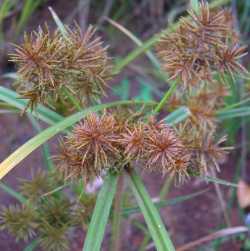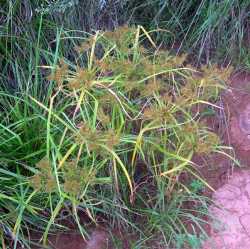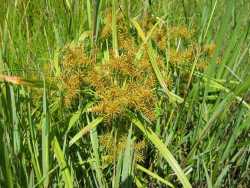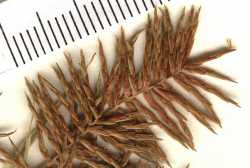Herbs, annual (or short-lived perennial). Culms trigonous, (4-)10-50(-130) cm × (0.5-)1-4 mm. Leaves flanged V- or inversely W-shaped, 5-30(-60) cm × 4-12 mm. Inflorescences: spikes 1-5(-12), loosely to densely cylindric, ovoid, or ± pyramidal, 10-20(-40) × (8-)10-30(-35) mm; rays (0-2)6-9(-12), 2-8(-13) cm; if rays absent, infloresence a single dense, capitate cluster of closely imbricate spikes; bracts (4-)5-8(-10), horizontal to ascending at 30-60°, (3-)10-25(-55) cm × 1-14 mm; rachilla hyaline or thickened bronze, carmine, or yellowish, wings clasping achene. Spikelets (10-)20-60(-100), linear-oblong to narrowly linear, cylindric to slightly flattened (when scale tips spreading), (5-)8-15(-38) × 0.8-1.3(-1.9) mm; floral scales (4-)8-12-(30), medially green, laterally reddish to stramineous to shiny brown or beige, medially 2-5-ribbed, laterally 1-3-ribbed, ovate to elliptic, (2-)2.2-2.8(-3.2) × (1.2-)1.4-1.6(-1.8) mm, apex entire or emarginate with mucro to 0.3 mm. Flowers: anthers (0.2-)0.3-0.4(-0.7) mm; styles 0.4-0.7(-1) mm; stigmas (1-)1.5-3 mm. Achenes brown, reddish brown, or black, stipitate, narrowly ellipsoid to oblong (rarely obovoid-oblong), (1-)1.2-1.5(-1.9) × 0.5-0.6(-0.75) mm, stipe 0.1-0.2 mm, apex acute to barely obtuse, surfaces finely papillose.
Fruiting summer-early fall. Emergent shorelines, disturbed, muddy places, fresh or slightly brackish marshes; 0-1500 m; Ont., Que.; Ala., Ariz., Ark., Calif., Colo., Conn., Del., D.C., Fla., Ga., Ill., Ind., Iowa, Kans., Ky., La., Maine, Md., Mass., Mich., Minn., Miss., Mo., Nebr., N.H., N.J., N.Mex., N.Y., N.C., Ohio, Okla., Oreg., Pa., R.I., S.C., S.Dak., Tenn., Tex., Vt., Va., Wash., W.Va., Wis.; Central America; South America; Asia; Africa; Pacific Islands (Hawaii); Australia.
As circumscribed here, Cyperus odoratus is easily identified by its cylindric to subcylindric spikelets in which the corky rachilla of the mature spikelet disarticulates at the base of each scale. The mature spikelet breaks into segments each consisting of a scale and an internode of the rachilla clasping the achene with its corky wings. Cyperus odoratus is an exceedingly variable pantropical and warm-temperate species. Numerous segregates have been named, some of which may deserve recognition when the species is studied in detail worldwide.
Annual herb with rhizomes and runners 10 cm - 0.5 m tall
Leaves: basal, alternate, 5 - 30 cm long, 2 - 12 mm wide, V-shaped or inversely W-shaped in cross-section, linear, parallel-veined, keeled beneath, with a sheathing base that encloses the stem.
Inflorescence: consisting of one to five terminal spikes, subtended by spirally arranged leafy bracts. Bracts five to eight, horizontal to ascending, unequal, 10 - 25 cm long, 1 - 14 mm wide, longer than the inflorescence. Rays (branches of inflorescence) zero to ten, 2 - 10 cm long. Spikes 1 - 2 cm long, 1 - 3 cm wide, loosely to densely cylindrical or egg-shaped or more or less pyramidal, consisting of 20 to 60 spikelets. If rays are lacking, the inflorescence is a single, dense, head-shaped cluster of spirally arranged and overlapping spikes.
Flowers: minute, in the axil of a floral scale, lacking sepals and petals. Stamens exserted. Anthers about 0.5 mm long. Pistil one. Style about 0.5 mm long. Stigma 1.5 - 3 mm long.
Fruit: a one-seeded achene, short-stalked, brownish or black, 1 - 1.5 mm long, about 0.5 mm wide, narrowly ellipsoid to oblong with a more or less pointed apex, three-angled, finely bumpy. Seed with a thin, non-adherent wall.
Culm: stout, 10 cm - 0.5 m long, 1 - 4 mm wide, triangular in cross-section, solid.
Spikelets: 8 - 15 mm long, 0.5 - 1.5 mm wide, linear, circular or slightly flattened in cross-section, subtended by two small bracts, with eight to twelve floral scales. Scales greenish down the middle, reddish to straw-colored or brownish along the sides, about 2.5 mm long and 1.5 mm wide, egg-shaped to elliptic with a rounded or tiny-pointed apex, two- to five-ribbed down the middle, one- to three-ribbed along the sides, lowest one empty.
Similar species: No information at this time.
Flowering: late July to early September
Habitat and ecology: Found on mudflats and along highways.
Occurence in the Chicago region: native
Etymology: Cyperus is the ancient Greek word for sedge. Odoratus means fragrant.
Author: The Morton Arboretum
Infrequent to frequent throughout the state. It grows in moist, wet, muddy or mucky soils of almost all kinds. [A form called C. engelmanni has somewhat separated flowers, i.e., on a single rachilla the successive scales do not reach the bases of those above. This form is ] infrequent in the lake area. All of my specimens are from the wet, sandy or muck borders of lakes.
Common Name: fragrant flatsedge
Duration: Annual
Nativity: Native
Lifeform: Graminoid
General: Annual herbaceous graminoid, occasionally a short-lived perennial, from fibrous roots; stems three-sided, 10-50 cm tall and 1-4 mm in diameter, solitary or tufted.
Vegetative: Leaves clustered at the base of the plant, linear and grass-like, 4-12 mm wide and shorter than the stems, v-shaped or w-shaped in cross section; inflorescence is subtended by a whorl of long leaf-like bracts.
Inflorescence: Inflorescence a red-bown dense capitate cluster of closely imbricate, ovoid spikes; rays 6-12, 10-100 mm; spikelets 20-60 per spike, linear, cylindric or slightly flat; flower bracts 6-24 per spikelet, 2-3 mm long, elliptic to ovate, light brown and splotched reddish, with a conspicuous midvein; achenes unequally 3-angled, 1-2 mm long, dark brown to black.
Ecology: Found in wet soils from 3,000-6,000 ft (914-1829 m); flowers July-October.
Distribution: Throughout much of the World: most of N. Amer. except western CAN; south through MEX to C. and S. America; in Africa, Aiustralia, Asia and Europe.
Notes: An annual nutsedge which lacks rhizomes and mostly occurs in wetlands; distinguished by the elongated, narrowly cylindric to subcylindric spikelets which disarticulate between each other on the inflorescence branch and thus do not leave an axis or rachis behind; also note the 3-sided seeds. Watch for the similar C. esculentus which differs by being a perennial with thin rhizomes; spikelets which fall off, leaving behind a naked winged inflorescence branch on the plant.
Ethnobotany: Seeds were eaten.
Etymology: Cyperus is from the Greek word meaning sedge; odoratus means fragrant.
Synonyms: Cyperus acicularis, Cyperus eggersii, Cyperus engelmannii, Cyperus ferax, Cyperus ferruginescens, Cyperus longispicatus, Cyperus macrocephalus, Cyperus macrocephalus var. eggersii, Cyperus odoratus var. acicularis, Cyperus odoratus var. engelmannii
Editor: SBuckley 2010, FSCoburn 2015, AHazelton 2017
Stout annual 1-8 dm; lvs 2-10 mm wide; bracts several, mostly surpassing the infl and some much elongate; rays (0-)3-10, 2-10 cm, branched at the top, producing a congested infl; prophylls prolonged 5-15 mm beyond the orifice into a bilobed tip; spikelets linear-cylindric, brownish at maturity, 1-2 cm, 5-20-fld, divaricately spreading; scales ovate, (1.5-)2-3 mm, finely several- nerved, obtuse or acute; rachilla articulate at the base of each scale, at maturity readily separating into joints, its internodes outwardly arcuate, conspicuously winged, the wings enfolding the achene; achenes brown, trigonously oblong or obovoid-oblong, 1-2 mm. Moist or wet soil; pantrop., n. to Mass., se. Me., Ont., Minn., and Kans. (C. engelmannii; C. ferax; C. ferruginescens; C. speciosus)
Gleason, Henry A. & Cronquist, Arthur J. 1991. Manual of vascular plants of northeastern United States and adjacent Canada. lxxv + 910 pp.
©The New York Botanical Garden. All rights reserved. Used by permission.










